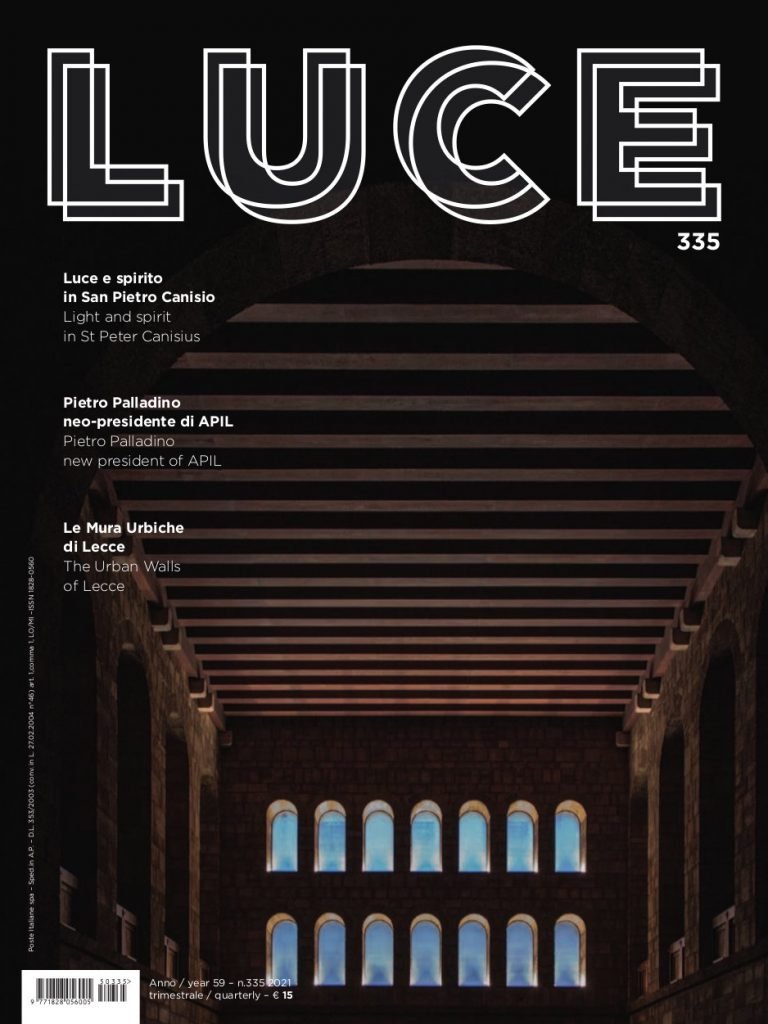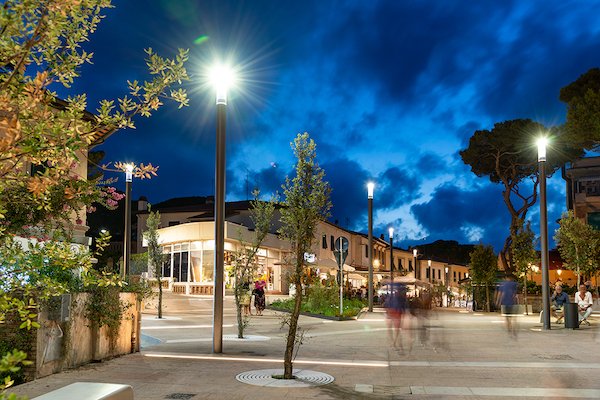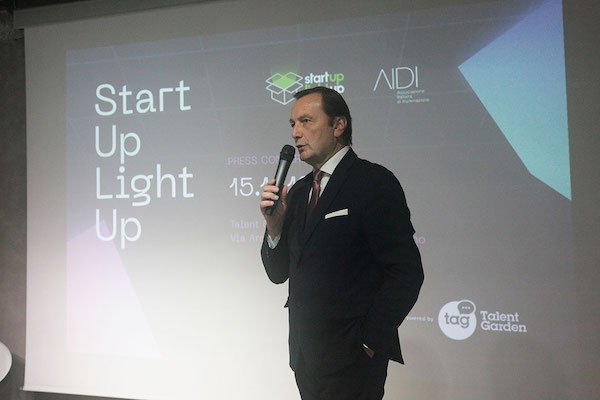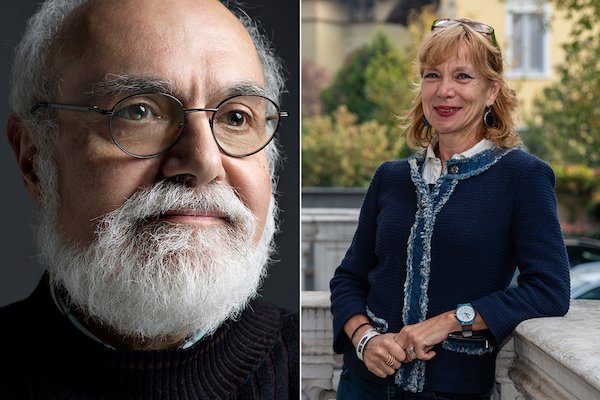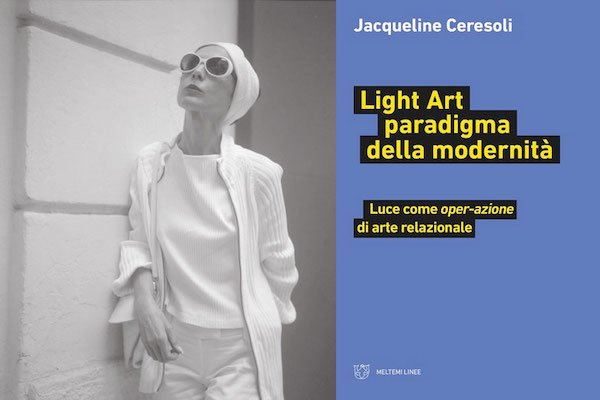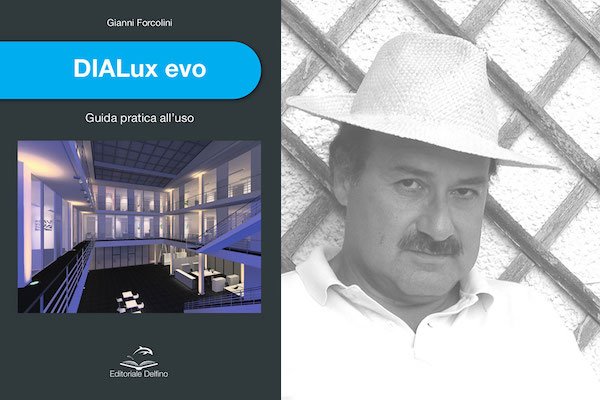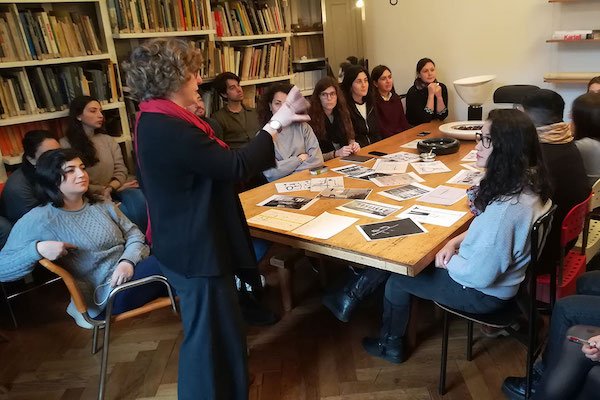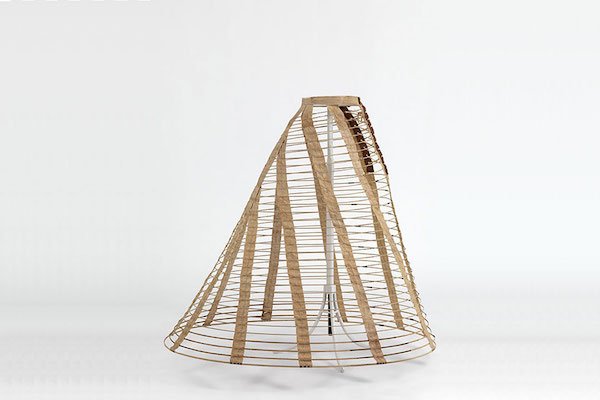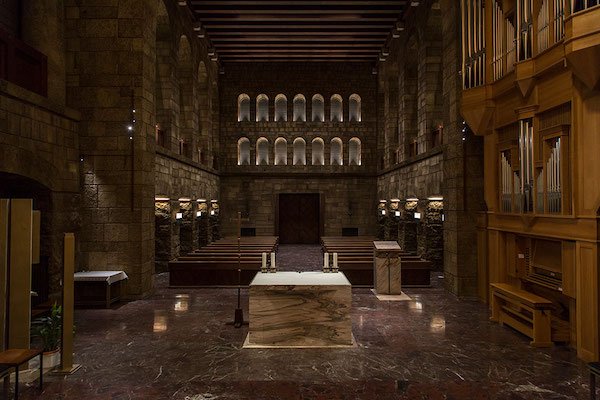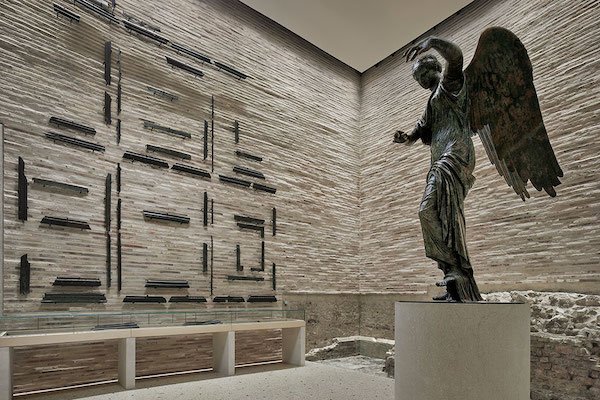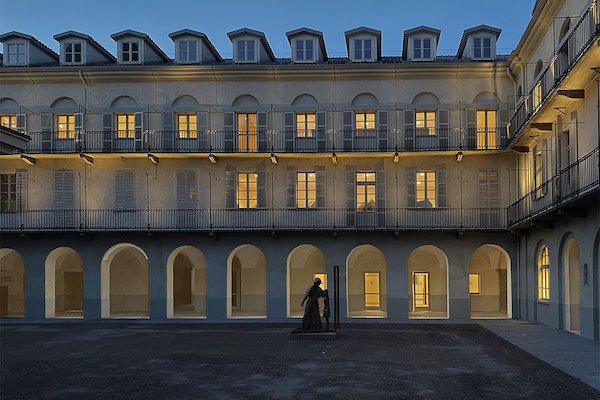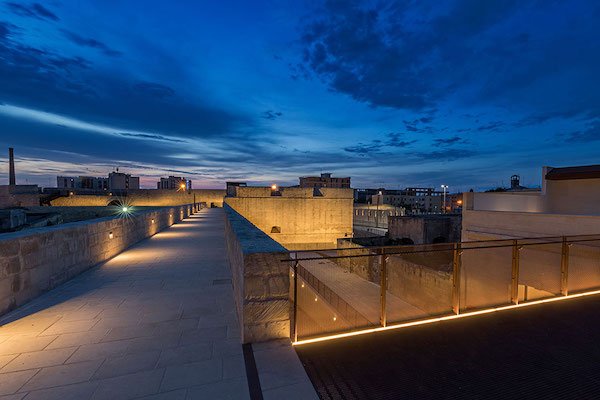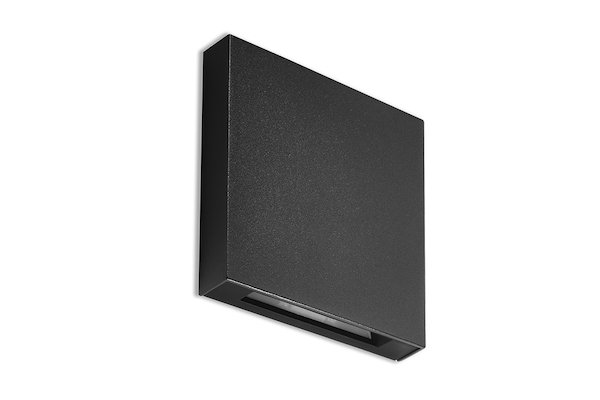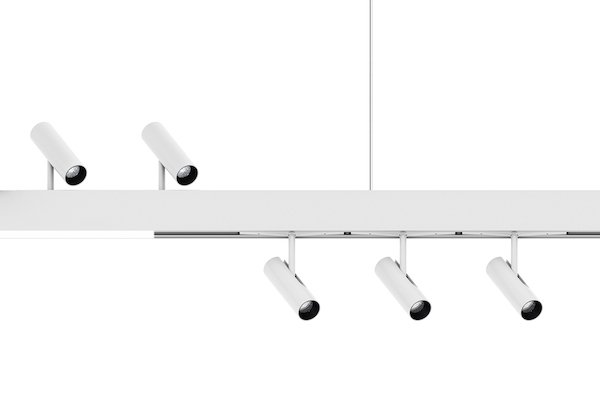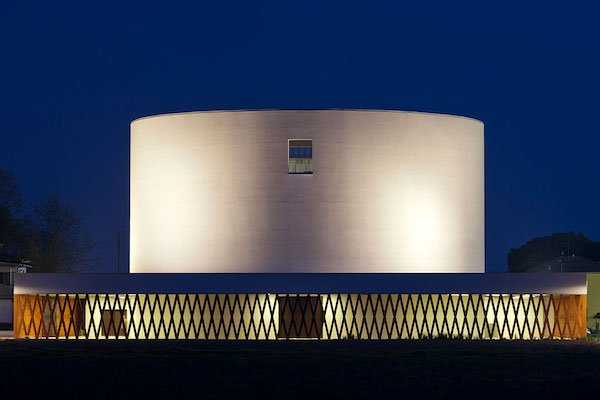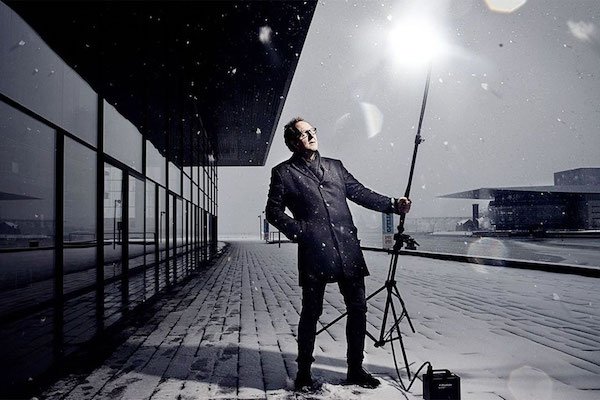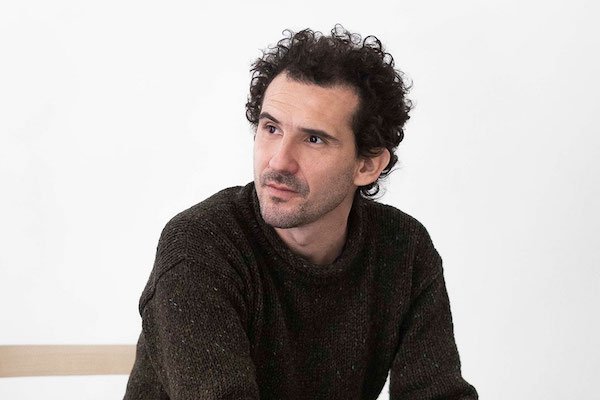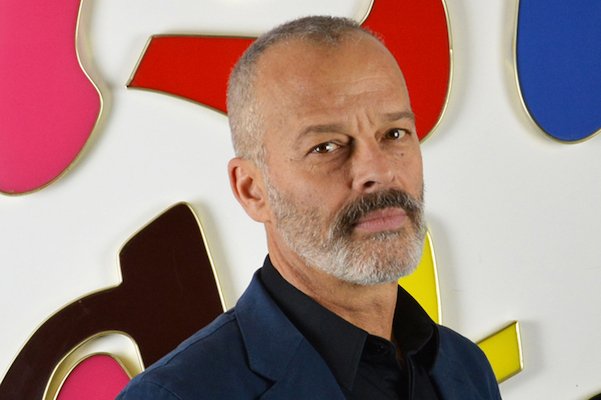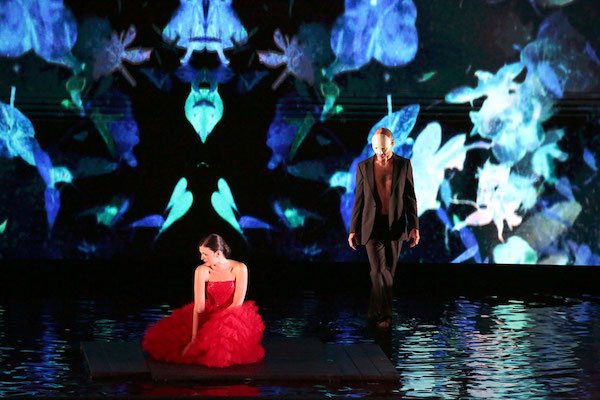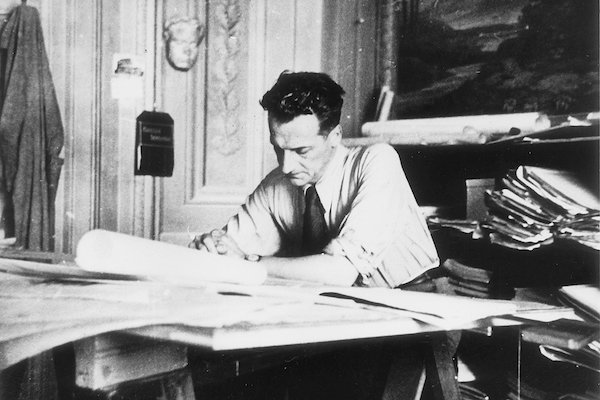LUCE 335 | PREVIEW
In this issue:
ASSOCIATIONS
LIGHTING DESIGNER, UN MESTIERE DIFFICILE: INTERVIEW WITH THE NEWLY APPOINTED APIL PRESIDENT, PIETRO PALLADINO
by Pietro Mezzi
Certification, training and broadening of the membership base: these are the central points of the programme that Pietro Palladino, APIL’s newly appointed president, intends to implement now that he is in charge of the association of Italian lighting professionals. Three objectives that are not easy to achieve, but which certainly represent the main knots to be untied in order to increase the quality of the profession and of the lighting product. “We must make it clear to all those who work in this sector that our work means quality of life and dwelling. That our activity represents an added value that we make available to the end user, to our professional colleagues and to the world of production.” In the new board, Giovanni Albertin, Paolino Batani, Ivano Bressan, Silvia Perego, Giacomo Rossi and Francesca Storaro have been elected to support the actions of the new president.
SPECIAL REPORT
LIGHTING FIXTURES: NEW TECHNOLOGIES AND NEW PRODUCTS. 5 QUESTIONS TO 7 COMPANIES
by Laura Bellia and Andrea Calatroni
For luminaire manufacturers, the pandemic, with the consequent restrictive measures, came within a global context already characterised by a strong evolution and promoter of policies oriented towards social welfare and environmental sustainability. This trend, supported by innovative technologies, has had the effect of bringing new products onto the market that still have to compete with international production, both in terms of cost and quality.
AIDI
AIDI TURNS CREATIVITY ON, FOR A SMARTER AND GREENER LIGHTING
by Mariella Di Rao
Companies, innovation and capital venture experts, journalists and incubators, all together, though only virtually, awarded the winners of the Start Up / Light Up competition, promoted and organised by AIDI in collaboration with Talent Garden. The contest winners are all young. Different curricula but the same desire to experiment with a great sensitivity for the environment and an increasingly smarter and greener vision of lighting. The 19th AIDI National Congress also took place in digital format with six webinars, as President Gian Paolo Roscio explained: “Because the dissemination of the culture of light cannot be stopped. Culture is an important antidote to tackle and overcome the difficult times we are experiencing.”
CIE ITALY
“PARTECIPATION IS KEY”: THE APPEAL OF THE COORDINATORS
by Pietro Mezzi
LUCE’s journey into the world of CIE, the Commission Internationale de l’Éclairage, continues. After presenting the work of Divisions 1 and 8 (LUCE 334), it is the turn of Divisions 4 and 6 of CIE Italy, coordinated respectively by Giuseppe Rossi and Laura Bellia, who explain why it is important to work within the Divisions, both nationally and internationally. The first deals with Lighting in Transportation and Exterior Applications, the second with Photobiology and Photochemistry. “Italian expertise is out of the question, we have to be there,” explains Rossi. For Bellia, the issue of participation is at the forefront of her thoughts: “I am optimistic. We also need to make those who are sceptical understand that Italy is still highly respected on the international scene”.
BOOKS
LICHT: LIGHT AS OPER-A(C)TION OF RELATIONAL ART
by Maurizio De Caro
It took the semantic elegance of Jacqueline Ceresoli with her new book – Light art paradigma della modernità. Luce come oper-azione di arte relazionale, Moltemi Linee, with the preface by Giulio Giorello that focuses the attention of the text on the high themes of the philosophy of perception and on the sociology of art – to define the conceptual perimeter of light in all its forms and throughout the sequence of experiences that have always conditioned and enhanced our lives. As a contributor to many magazines and newspapers, Ceresoli has written about Lucio Fontana, Dan Flavin, Robert Irwin, James Turrell, Olafour Eliasson, Mario Merz, Joseph Kosuth, Cerith Wyn Evans, Carsten Höller, Philippe Parreno. Pier Paolo Calzolari, Maurizio Nannucci and other artists. A complex and profound work, as is the author’s writing, but always full of insightful disciplinary stimulation that invites us to delve into the very essence of “seeing and looking” and thus give luminous meaning to objects: whether in the path of art or as moments of research in design and lighting technology.
GUIDE TO THE PRACTICAL USE OF THE DIALUX EVO SOFTWARE
by Gianni Forcolini
Edited by the author, an architect and lecturer, and published by Editoriale Delfino, this practical user’s guide summarises the many functions of the software, arranged according to the type of project. DIALux evo is a “free” software for photometric calculation and rendering, currently among the most widely used by lighting designers, interior designers, architects, engineers, etc. In the Guide, practical examples are used to apply the procedures to obtain the full range of calculation results and the corresponding renderings of lighting scenes. And, as the author writes, there is “plenty of room for creativity.” After all, we are well aware that there are many variables in the field of perception, and that “modelling” does not always respond to the complex physiological and psychological phenomena we expect.
EDUCATION
TEACHING LIGHT DURING THE LOCK-DOWN
by Andrea Siniscalco
As the years go by, the role of the lighting designer is becoming more recognised, and while it is true that there is still a long way to go, writes Siniscalco, a professor at the Politecnico di Milano, it cannot be denied that there is more awareness of the world of lighting than there was a decade ago. Whereas it was once only possible to rely on short courses, today the subject is taught in its many aspects. He mentions the Politecnico in Milan and Turin, the Federico II in Naples, the Fine Arts Academy in Macerata, the Tor Vergata University in Rome, Sapienza University in Rome, the IUAV in Venice, the University of Florence, but also associations, such as AIDI, which are actively involved in training. The offer is manifold and at various levels, “From short courses to university Specialising Masters, interested parties can choose the programme that best suits them; because in the end, the difference between all educational realities is mostly related to the construction of the teaching programme, which requires skills.”
LUCE’S NOTEBOOKS
LIGHTS WITH SKIRTS
by Francesco Ciulli
The author sees a proliferation of lighting “fixtures” (objects), mostly suspended, that have a kind of “cage” around the bulb, like a structure that should support a diffusing material that is not there. There is only the structure, made of various materials. Here the author dwells at the tip of his pen on a number of historical luminaires of great value, whose unifying feature is the uncovered or visible light bulb.
ANNIVERSARY
ANNIVERSARY
by Jacqueline Ceresoli
To contain in one article the history of Venini, founded in 1921 and destined to become a brand of Made in Italy excellence in the world, with a recognisable style, is an arduous task. Its success depends on the ability to draw on the creativity of important protagonists of the 20th century, such as Carlo Scarpa, Gio Ponti, Fulvio Bianconi, Pietro Chiesa, Ettore Sottass, Tadao Ando, Gae Aulenti, Fernando & Humberto Campana and other designers who have shared a project of beauty with Venetian craftsmen. A story that now celebrates 100 years of fatal attraction between light and glass.
DESIGNING LIGHT
LIGHT AND SPIRIT: THE LIGHTING OF THE ST PETER CANISIUS CHURCH IN ROME
by Alessandra Reggiani
In the heart of Rome, the Church of St Peter Canisius is a private space of the Pontifical Germanic-Hungarian College, a very important institution linked to the city since the second half of the 16th century. The beauty and architectural rigour of the church named after Canisius represent and enhance its long and important tradition of philosophical and theological teaching. Here light takes on an even more fundamental symbolic value, it is “a visible medium – as was written by Witelo – capable of expressing the invisible, i.e. the divine.” The lighting project was designed to achieve precise technical objectives, through a recovery of aesthetic and religious values; an intervention that is in harmony with the specificity of the place and its formal and liturgical identity. A project that shows how light can nowadays play a leading role, being able to move and enhance the places of the History of our immense artistic heritage, resulting in a qualitative and conservative renovation.
BRESCIA: A NEW LIGHT FOR THE WINGED VICTORY
by Cristina Ferrari
Last February in Brescia, even if only for a few days, it was once again possible to admire the Winged Victory, the splendid bronze statue dating back to the first century A.D. that has become one of the symbols of the city, recently returned “home” after an absence of more than two years for restoration. Discovered in 1826 together with other bronzes between two walls of the Capitoline Temple, the sculpture is now enhanced by the new exhibition design by Spanish architect Juan Navarro Baldeweg, which enhances its historical and archaeological features, as well as ensuring its optimal conservation.
LIGHT INTENSITY AND QUALITY FOR THE ENHANCEMENT OF HISTORIC PLACES, SUSTAINABILITY AND HEALTH IN THEIR PROXIMITY: THE SCERVINO SPACE IN FLORENCE
by Carla Balocco and Simona Carbone
The authors, from the University of Florence, address the complex issue of designing the lighting in a historically prestigious architectural space dedicated to the precious and exclusive tailoring art of Ermanno Scervino. Capable of taking us along paths of new and interesting visual experiences, the new lighting, a mixture of natural and artificial light, is obtained with technical control/regulation solutions and bioclimatic ones (the tropical plants that filter and transform it). Minimally invasive, energetically sustainable and easy to maintain, these solutions guarantee the protection of the unique fabrics and materials.
LIGHTS ON THE DON BOSCO HOUSE MUSEUM IN TURIN
by Sergio Sabbadini and Marco Pollice
In the Don Bosco House Museum, where the buildings tell of themselves and of their history linked to the birth of Salesianism, natural and artificial light is one of the prevailing design components that involves all levels, from the roof to the basement rooms. A light that is designed, revealed, and shaped with respect to the architectural project; lights and shadows that make the discovery, the details of a painting, of clothes, and of a place available to our senses. A museum lighting design that takes into account several aspects: the staging of the architecture, the communication of a comfortable atmosphere, the reading of the artworks, a good orientation within the spaces and an overall pleasantness.
THE URBAN WALLS OF LECCE
by Patrizia Erroi and Andrea Ingrosso
A central area at the northern entrance to the city, between the inner city ring road and a surviving section of the 16th-century city walls, was until a few years ago used as a car park and perceived as peripheral, lacking the environmental connotations and qualities that would make the site’s historical and monumental value appreciated. The area has been the subject of a redevelopment project aimed at the recovery of the surviving section of the city walls, the landscaping with the reopening of the moat in front of the walls, and the recovery of the intra moenia garden, part of the sixteenth-century Palazzo Giaconia, which was in a state of decay and neglect. The major restoration and environmental redevelopment works have endowed the city with an area of outstanding cultural and touristic appeal that has now become a privileged destination for the city’s inhabitants and visitors. A new, unprecedented scenario, where light is the protagonist.
MAKING OF
SANS SERIF: THE SILENCE OF FORM
by Andrea Calatroni
At Cariboni, the Sans Serif project was born with the aim of creating a line of wall-mounted floor-washers with high visual comfort. These products are designed to illuminate both indoor and outdoor walkways. The idea behind the project is simple: an on-wall floor-washer that illuminates the walkway without illuminating itself and that guarantees pleasant and discreet lighting. This is best explained by the words of the brilliant young lighting designer Miriam Emiliano, “a silent product, focused on providing the right light.”
ROBIN: WITH AN EYE TO THE SKY
by Andrea Calatroni
iGuzzini and Matteo Thun collaborate for the first time to create Robin, a system of projectors mounted on tracks with a very evocative design. Like many projects by the architect from Bolzano, this one draws inspiration from nature: “Robin starts from my passion for flying. Flying means dematerialising, it means absolute freedom and it means above all being above and not below.” This is the vision that inspired Thun in designing this new ultra-low voltage projector.
INTERVIEWS
CORVINO + MULTARI: THE ARCHITECT DIALOGUES WITH SAINT AUGUSTINE
by Andrea Calatroni
The author caught up with Giovanni Multari, of the Corvino + Multari studio, to tell us about them and their idea of light, equally divided between Naples and Milan. Founded in Naples in 1995, the studio began operating in Milan a few years later. Two realities, Naples and Milan, apparently different, but with many links. The former is the place of training, of continuous experimentation on areas that have been inhabited for thousands of years and that face the light of the Mediterranean. In Milan, with its defined horizon stretching between the mountains and the plain, the meeting with the architecture of the second half of the 20th century, with the masters, as in the restoration of Gio Ponti’s Pirelli tower. “Connected cities, where we mostly experienced affinities rather than differences and whose legacies are the heritage of all.”
LIGHTING DESIGNERS
JESPER KONGSHUAG: “SWITCHING ON THE LIGHTS IS ALWAYS A FANTASTIC MOMENT”
by Andrew Peterson
The author met with Jesper Kongshuag, a Danish lighting designer who works in the fields of theatre, opera, ballet and architecture, to ask him about the differences between architectural and theatre lighting, the Super Human ballet and the lighting designs for building such as the Danish Maritime Museum or the Lego House. Light, Kongshuag explains, is something that always grows out of darkness, and it is very important to understand this. “It’s worth spending time on lighting precisely because it creates an interaction between people and architecture, music and all sorts of things!”
DESIGNERS
THE SEARCH FOR DESIGN WITHOUT DECEPTION: INTERVIEW WITH FRANCESCO FACCIN
by Federica Capoduri
Born in Milan in 1977, Francesco Faccin has all the credentials to be defined as a future Master, a pupil of that invisible school that the wiser ones – such as Enzo Mari and then Michele De Lucchi – taught him. We interviewed him, fascinated by one of his latest projects: Pepa, a lamp created for Astep, a Danish-based but very Italian company headed by Alessandro Sarfatti, grandson of Gino – one of Italy’s leading lighting designers, founder of Arteluce – and son of Riccardo – architect, designer, entrepreneur, for years president of Assoluce and vice-president of FederlegnoArredo, who in 1979 together with Paolo Rizzatto and Sandra Severi gave life to the legendary Luceplan. Talking about design, materials, environment and his students, he reveals: “I started working in lighting a few years ago, I’m having fun and learning.”
COSMOLIGHT: MARCO MENCACCI’S GLASSGALACTIC JOURNEY
by Francesco Ciulli
Mencacci lives and works in Paris, and is making his umpteenth foray into the world of lighting glass. He doesn’t know any preferential or reassuring lanes, he experiments and risks every time, then starts again. He works hand in hand with the master glassmaker, and adds original details and effects to these free forms; each character is made of transparent glass, the colour comes from the artificial light passing through a chromatic filter. He takes us on a dreamlike journey populated by rounded, transparent and luminous beings who dialogue with each other, becoming a tale, a story, a saga.
SHOWTIME
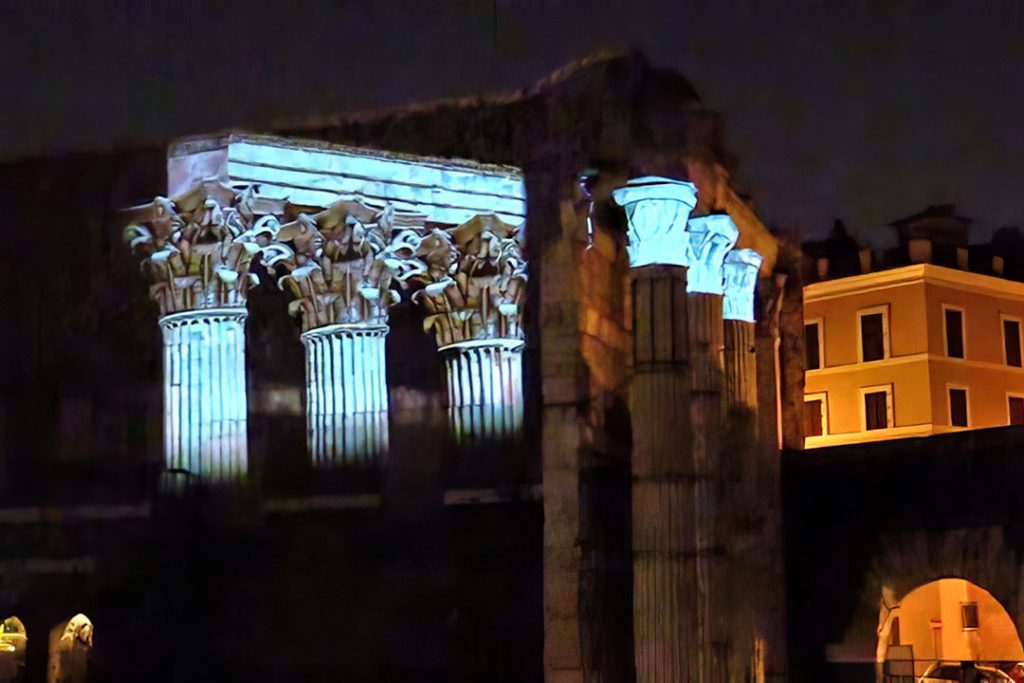
ARCHAEOLOGY AND TECHNOLOGY MEET: STUDIO CAPASSO’S VIRTUAL RECONSTRUCTIONS
by Cristina Ferrari
Can a passion revolutionise the way we perceive archaeology? Because it is from a passion for the history of virtual archaeology that a company specialising in the creation of graphic engines for virtual reality was born, a veritable “modern Renaissance workshop”, as Piero Angela called it. From Journey to Pompeii to the remains of the Imperial Age domus of Palazzo Valentini in Rome, from the Forum of Augustus to the Forum of Caesar, it is a philologically and archaeologically perfect reconstruction carried out in collaboration with archaeologists and art historians that will be a testimony for future generations of scholars.
MAGIC LANTERN
A RIVEDER LE STELLE: TEATRO ALLA SCALA’S PREMIERE, WITHOUT THE AUDIENCE AND BROADCASTED WORLDWIDE
by Marcello Filibeck
On December 7th, the Teatro alla Scala in Milan was scheduled to hold its premiere, the traditional event that opens the new opera season. Gaetano Donizetti’s Lucia di Lammermoor was due to be staged, but a few weeks before its debut the performance was cancelled as a consequence of the coronavirus pandemic. The Teatro alla Scala decided not to give up its most important evening and invited director Davide Livermore to create from scratch an opera intended exclusively for television broadcasting: A riveder le stelle. An original and ambitious project with which La Scala experimented with new formats and new languages, and which deserves to be explored in depth in order to understand its peculiarities. The author spoke about it with Davide Livermore (director), Paolo Cucco (director of D-WOK, the company that created the video scenography) and Marco Filibeck (lighting designer).
ARCHITECTS IN LIGHT
GIOVANNI MICHELUCCI
by Empio Malara
When the sky is clear, light filters through the windows, illuminating and enhancing the interior of Florence’s Santa Maria Novella station, designed in 1932 by a group of Tuscan architects led by Giovanni Michelucci. This is how the first modern station in Italy was built, in 1935; one of the most significant works of architect Giovanni Michelucci’s (1891-1990) “clean and refined” rationalism, as Cesare De Seta points out.
